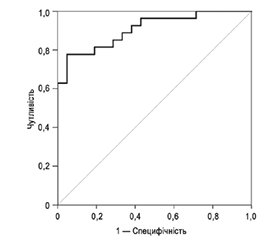Международный неврологический журнал Том 20, №1, 2024
Вернуться к номеру
Роль клінічних характеристик Лайм-бореліозу в прогнозуванні когнітивних порушень
Авторы: Малиш Т.Ю.
Національний університет охорони здоров’я України імені П.Л. Шупика, м. Київ, Україна
Рубрики: Неврология
Разделы: Клинические исследования
Версия для печати
Актуальність. Хвороба Лайма характеризується широким поліморфізмом клінічних проявів, серед яких — різноманітні ураження центральної та периферичної нервової системи. Поряд з неврологічними порушеннями часто виявляються різноманітні прояви й ознаки когнітивних розладів. Незважаючи на значну поширеність когнітивних порушень при Лайм-бореліозі, дані про їх частоту і фактори ризику є суперечливими, а перевірка когнітивного статусу досі не включена в стандартне клінічне обстеження цієї категорії пацієнтів. Мета: з’ясувати предиктори, що можуть незалежно впливати на розвиток когнітивної дисфункції у хворих на Лайм-бореліоз. Матеріали та методи. Нами проведено проспективне когортне дослідження за участю 69 (47 жінок, 22 чоловіки) пацієнтів з верифікованим діагнозом Лайм-бореліозу віком від 23 до 77 років (у середньому 49,9 ± 16,26 року). Для оцінки когнітивних функцій використовували Монреальську шкалу оцінки когнітивних функцій (MoCA). Для визначення взаємозв’язку між когнітивною дисфункцією та імовірними її предикторами учасники дослідження були поділені на дві групи — пацієнти без когнітивних порушень (n = 30) і пацієнти з когнітивною дисфункцією (n = 39) згідно з показниками шкали МоСА. Результати. Встановлено, що факторами ризику розвитку когнітивної дисфункції є: встановлення діагнозу Лайм-бореліозу у віці 45,5 року і більше (співвідношення шансів (СШ) 5,09; 95% ДІ [1,82–14,27]; р = 0,001), наявність нейробореліозу (СШ 5,98; 95% ДІ [2,0–17,8]; р < 0,001), Лайм-кардиту (СШ 8,7; 95% ДІ [1,04–73,06]; р = 0,021), артеріальної гіпертензії (СШ 7,19; 95% ДІ [2,32–22,28]; р < 0,001), тривожних розладів. Висновки. Перспективою подальших досліджень є вивчення та аналіз особливостей кореляційних зв’язків когнітивних і психоемоційних порушень з якістю життя пацієнтів з різними формами й тривалістю Лайм-бореліозу.
Background. Lyme disease is characterized by a wide polymorphism of clinical manifestations, including various lesions of the central and peripheral nervous systems. Along with neurological disorders, diverse manifestations and signs of cognitive impairments are often found. Despite the high prevalence of cognitive disorders in Lyme borreliosis, data on their frequency and risk factors are contradictory. The examination of cognitive status is still not included in the standard clinical examination of this category of patients. The aim of the study is to identify predictors that may independently influence the development of cognitive dysfunction in patients with Lyme borreliosis. Materials and methods. A prospective cohort study of 69 patients (47 females, 22 males) diagnosed with Lyme borreliosis, aged between 23 and 77 (average of 49.90 ± 16.26) years, was carried out. The Montreal Cognitive Assessment was used to evaluate cognitive function. To determine the relationship between cognitive dysfunction and its potential predictors, the participants were divided into two groups: patients without cognitive impairment (n = 30) and those with cognitive dysfunction (n = 39) based on the Montreal Cognitive Assessment score. Results. It was found that risk factors for the development of cognitive impairment include: diagnosis of Lyme borreliosis at the age of 45.5 years and older (hazard ratio (HR) 5.09; 95% confidence interval (CI) [1.82–14.27]; p = 0.001), presence of neuroborreliosis (HR 5.98; 95% CI [2.0–17.8]; р < 0.001), Lyme carditis (HR 8.7; 95% CI [1.04–73.06]; р = 0.021), hypertension (HR 7.19; 95% CI [2.32–22.28]; р < 0.001), anxiety disorders. Conclusions. The prospect for further research is to study and analyze the features of the correlation between cognitive and psycho-emotional disorders and the quality of life of patients with different forms and duration of Lyme borreliosis.
Лайм-бореліоз; когнітивні розлади; фактори ризику
Lyme borreliosis; cognitive deficits; risk factors

